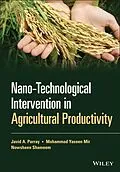Provides detailed information about the use of nanotechnology in remediating waste and pollution in agriculture
Nano-Technological Intervention in Agricultural Productivity explores sustainable, eco-friendly technologies for remediating wastes and contaminated areas in both water and land ecosystems. Focusing on nano-technological innovations that use microbes and microbial agents to improve the quality and pollutant discharge of contaminated sites, this comprehensive volume also discusses molecular approaches for the characterization of nanoparticles, the biosynthetic pathways of microbes, gene and protein expression studies for bio-deterioration techniques, and more.
Organized into nine chapters, the book opens with a thorough overview of the functions, classification, properties, synthesis, and applications of nanoparticles. Following a discussion of the environmental and agricultural implications of nanotechnology, the authors examine the current role and future prospects of nanotechnology in managing plant diseases, improving agri-food production, and increasing agricultural productivity. Subsequent chapters cover lignin nanoparticles, various applications of nanotechnology in agriculture, and nano-based advances in plant and microbial science. Offering an up-to-date account of the role of nanotechnologies in agricultural bioremediation, this book:
* Explores biotechnological advances in the development of sophisticated green technologies for waste minimization and waste control
* Emphasizes the use of microbes for degradation and removal of various xenobiotic substances
* Discusses bioremediation approaches in relation to the impact of increased urbanization and industrialization on the environment
* Covers a variety of applications of nanotechnology in agriculture, including nano-fertilizers, nano-biosensors, nano-pesticides, and nanoparticle protection in plants
Nano-Technological Intervention in Agricultural Productivity is a valuable resource for students in plant biotechnology and agricultural science and engineering, as well as an important reference for researchers in plant biotechnology and agricultural sciences, particularly those with interest in the use of nanomaterials for pollution remediation and sustainable development.
Autorentext
Javid A. Parray, Assistant Professor, Higher Education Department, Government Degree College Eidgah, Srinagar, India.
Mohammad Yaseen Mir, Department of School Education, University of Kashmir, Srinagar, India.
Nowsheen Shameem, Assistant Professor, Department of Environmental Science, Cluster University Srinagar, Jammu and Kashmir, India.
Inhalt
About the Authors xi
About the Book xiii
1 Nanotechnology and Nanoparticles 1
1.1 Nanoparticles and Their Functions 1
1.2 Classification of NPs 2
1.2.1 Carbon-Based NPs 2
1.2.2 Metal Nanoparticles 2
1.2.3 Ceramic NPs 3
1.2.4 Semiconductor NPs 3
1.2.5 Polymeric NPs 3
1.2.6 NPs Based on Lipids 4
1.3 Synthesis of Nanoparticles 4
1.3.1 Top-Down Synthesis 4
1.3.2 Bottom-Up Synthesis 5
1.4 NPs and Characterization 6
1.4.1 Morphological Characterization 6
1.4.1.1 SEM Technique 6
1.4.1.2 TEM Technique 6
1.4.2 Structural Characteristics 7
1.4.2.1 XRD 7
1.4.2.2 Energy-Dispersive X-ray (EDX) 7
1.4.2.3 XPS 7
1.4.2.4 FT-IR and Raman Spectroscopies 8
1.4.3 Particle Size and Surface Area Characterization 8
1.4.4 Optical Characterizations 8
1.5 Physicochemical Properties of NPs 9
1.5.1 Mechanical and Optical Properties 9
1.5.2 Magnetic Properties 9
1.5.3 Mechanical Properties 10
1.5.4 Thermal Properties 10
1.6 Functions of NPs 10
1.6.1 Drugs and Medications 11
1.6.2 Materials and Manufacturing 11
1.6.3 Environment 12
1.6.4 Electronics 12
1.6.5 Energy Harvesting 12
References 13
2 Implications of Nanotechnology and Environment 21
2.1 Ecotoxicological Implications of Nanoparticles 21
2.1.1 Ecotoxicity of Fullerenes 23
2.1.2 Ecotoxicity of Carbon Nanotubes 23
2.1.3 Ecotoxicity of Metal Nanoparticles 23
2.1.4 Ecotoxicity of Nanocomposites 24
2.1.5 Ecotoxicity of Oxide Nanoparticles 25
2.2 Nanotechnology and Agriculture 26
2.3 Risk Assessment Factors and Modulation of Nanomaterials 27
References 30
3 Nanotechnology and Disease Management 37
3.1 Recent Advancements in Plant Nanotechnology 37
3.1.1 Cerium Oxide (CeO2) NPs 38
3.1.2 Silver NPs 38
3.1.3 Titanium Dioxide (ToO2) NPs 39
3.1.4 Zinc Oxide (ZnO) NPs 41
3.1.5 Cupric Oxide (CuO) NPs 41
3.1.6 Gold NPs (GNPs) 42
3.1.7 Carbon Nanotubes 42
3.1.8 Nickel Oxide NPs 43
3.2 Nanotechnology: Role in Plant-Parasitic Control 43
3.2.1 Nanocapsules: Liposomes and Polymers 44
3.2.1.1 Potential Uses in Controlling ParasiticWeeds 44
3.3 Abiotic Stress-Tolerant Transgenic Crops and Nanotechnology 45
3.3.1 Nanotechnology in Gene Transfer Experiments 45
3.4 Plant Pathogens and Nanoparticle Biosynthesis 46
3.4.1 Bacteria-Mediated Biosynthesis 47
3.4.2 Fungal Mediated Biosynthesis 48
3.5 Nanomaterial and Plant Protection Against Pests and Pathogens 49
3.6 Future Perspectives 51
References
